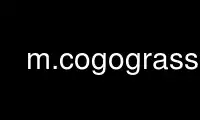
This is the command m.cogograss that can be run in the OnWorks free hosting provider using one of our multiple free online workstations such as Ubuntu Online, Fedora Online, Windows online emulator or MAC OS online emulator
PROGRAM:
NAME
m.cogo - A simple utility for converting bearing and distance measurements to coordinates
and vice versa.
It assumes a cartesian coordinate system
KEYWORDS
miscellaneous, distance
SYNOPSIS
m.cogo
m.cogo --help
m.cogo [-lrc] [input=name] [output=name] [coordinates=east,north] [--overwrite]
[--help] [--verbose] [--quiet] [--ui]
Flags:
-l
Lines are labelled
-r
Convert from coordinates to bearing and distance
-c
Repeat the starting coordinate at the end to close a loop
--overwrite
Allow output files to overwrite existing files
--help
Print usage summary
--verbose
Verbose module output
--quiet
Quiet module output
--ui
Force launching GUI dialog
Parameters:
input=name
Name of input file
Default: -
output=name
Name for output file
Default: -
coordinates=east,north
Starting coordinate pair
Default: 0.0,0.0
DESCRIPTION
m.cogo converts data points between bearing and distance and X,Y coordinates. Only simple
bearing/distance or coordinate pairs are handled. It assumes a cartesian coordinate
system.
Input can be entered via standard input (default) or from the file input=name. Specifying
the input as "-" also specifies standard input, and is useful for using the program in a
pipeline. Output will be to standard output unless a file name other than "-" is
specified. The input file must closely adhere to the following format, where up to a 10
character label is allowed but not required (see -l flag).
Example COGO input:
P23 N 23:14:12 W 340
P24 S 04:18:56 E 230
...
The first column may contain a label and you must use the -l flag so the program knows.
This is followed by a space, and then either the character ’N’ or ’S’ to indicate whether
the bearing is relative to the north or south directions. After another space, the angle
begins in degrees, minutes, and seconds in "DDD:MM:SS.SSSS" format. Generally, the angle
can be of the form digits + separator + digits + separator + digits [+ ’.’ + digits]. A
space follows the angle, and is then followed by either the ’E’ or ’W’ characters. A space
separates the bearing from the distance (which should be in appropriate linear units).
Output of the above input:
-134.140211 312.420236 P23
-116.832837 83.072345 P24
...
Unless specified with the coord option, calculations begin from (0,0).
NOTES
For those unfamiliar with the notation for bearings: Picture yourself in the center of a
circle. The first hemispere notation tell you whether you should face north or south.
Then you read the angle and either turn that many degrees to the east or west, depending
on the second hemisphere notation. Finally, you move <distance> units in that direction
to get to the next station.
m.cogo can be run either non-interactively or interactively. The program will be run
non-interactively if the user specifies any parameter or flag. Use "m.cogo -", to run the
program in a pipeline. Without any flags or parameters, m.cogo will prompt for each value
using the familiar GRASS parser interface.
This program is very simplistic, and will not handle deviations from the input format
explained above. Currently, the program doesn’t do anything particularly useful with the
output. However, it is envisioned that this program will be extended to provide the
capability to generate vector and/or sites layers.
Lines may be closed by using the -c flag or snapped with v.clean, lines may be converted
to boundaries with v.type, and closed boundaries may be converted to areas with
v.centroids.
EXAMPLES
m.cogo -l in=cogo.dat
Where the cogo.dat input file looks like:
# Sample COGO input file -- This defines an area.
# <label> <bearing> <distance>
P001 S 88:44:56 W 6.7195
P002 N 33:34:15 W 2.25
P003 N 23:23:50 W 31.4024
P004 N 05:04:45 W 25.6981
P005 N 18:07:25 E 22.2439
P006 N 27:49:50 E 75.7317
P007 N 22:56:50 E 87.4482
P008 N 37:45:15 E 37.7835
P009 N 46:04:30 E 11.5854
P010 N 90:00:00 E 8.8201
P011 N 90:00:00 E 164.1128
P012 S 48:41:12 E 10.1311
P013 S 00:25:50 W 255.7652
P014 N 88:03:13 W 98.8567
P015 S 88:44:56 W 146.2713
P016 S 88:44:56 W 18.7164
Round trip:
m.cogo -l input=cogo.dat | m.cogo -rl in="-"
Import as a vector points map:
m.cogo -l input=cogo.dat | v.in.ascii output=cogo_points x=1 y=2 separator=space
Shell script to import as a vector line map:
m.cogo -l input=cogo.dat | tac | awk ’
BEGIN { FS=" " ; R=0 }
$1~/\d*\.\d*/ { printf(" %.8f %.8f\n", $1, $2) ; ++R }
END { printf("L %d\n", R) }’ | tac | \
v.in.ascii -n format=standard out=cogo_line
Convert that lines map into an area:
# Add the -c flag to the above example to close the loop:
m.cogo -l -c input=cogo.dat | ...
...
v.type input=cogo_line output=cogo_boundary from_type=line to_type=boundary
v.centroids input=cogo_boundary output=cogo_area
If necessary, snap the boundary closed with the v.clean module. Use tool=snap and
thresh=0.0001, or some small value.
Use m.cogograss online using onworks.net services
